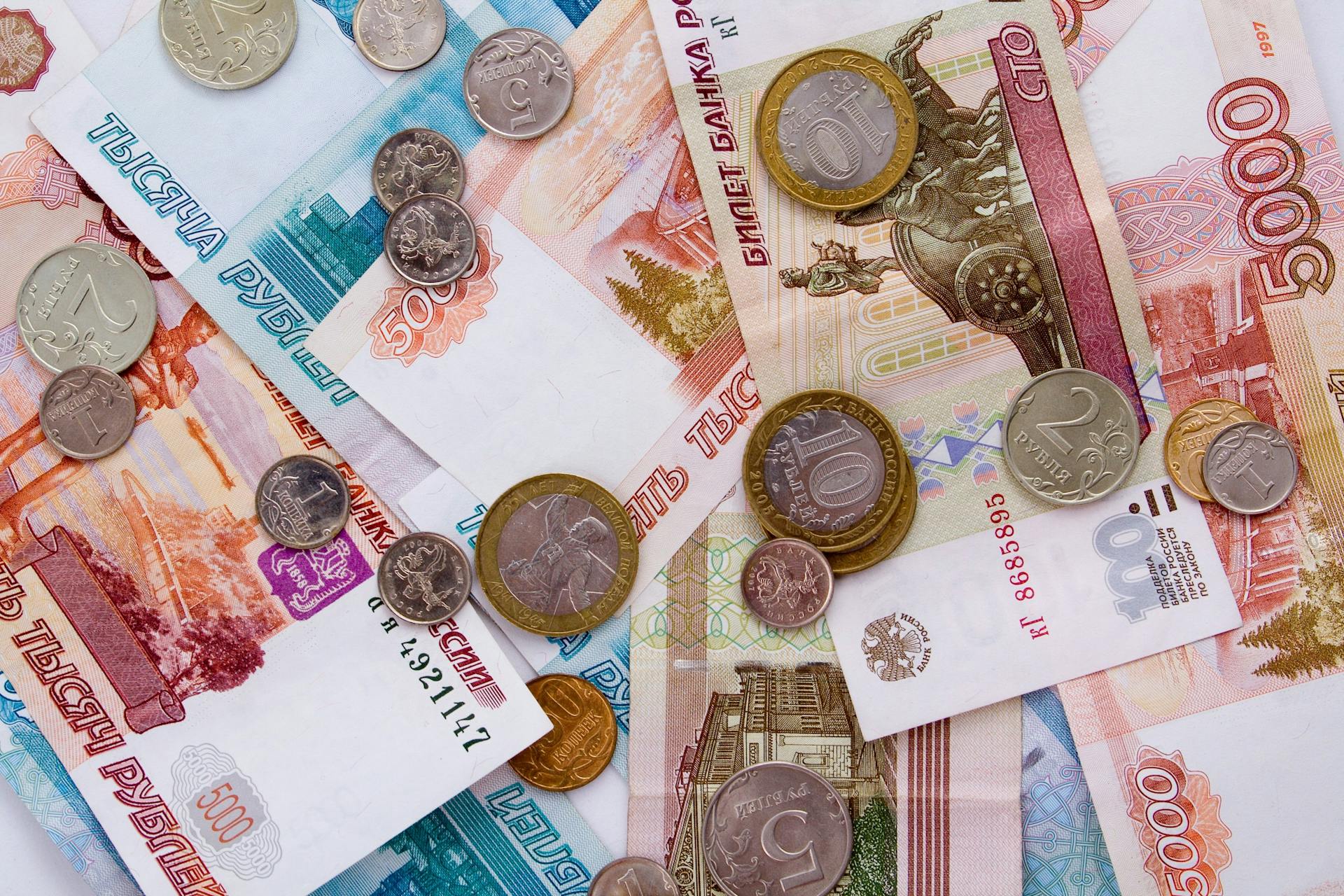
Required return is a fundamental concept in finance that helps investors and businesses make informed decisions. It's essentially the minimum rate of return an investment or project must earn to be considered viable.
The required return is calculated based on the cost of capital, which is the minimum return an investor requires for the risk they're taking on. This can be thought of as the interest rate on a loan.
A key factor in determining the required return is the risk-free rate, which is the return an investor can expect from a low-risk investment, such as a government bond. The risk-free rate serves as a benchmark for calculating the required return.
The required return is also influenced by the market risk premium, which is the additional return an investor demands for taking on market risk. This premium is calculated by subtracting the risk-free rate from the expected market return.
For another approach, see: Taking a Risk Definition
Calculating Required Return
Calculating Required Return is a crucial step in evaluating investments. There are several methods to calculate it, but two of the most widely used are the Capital Asset Pricing Model (CAPM) and the Dividend Discount Model (DDM).
The CAPM uses the beta of an asset to measure its risk, with stocks having betas greater than 1 considered riskier than the market. The formula for RRR using CAPM is RRR = Risk-free rate of return + Beta X (Market rate of return - Risk-free rate of return).
For example, if the risk-free rate is 2%, the market rate of return is 10%, and the beta of a stock is 1.50, the RRR would be 14% (2% + 1.50 X (10% - 2%)).
The DDM, on the other hand, calculates RRR using the current stock price, the dividend payment per share, and the forecasted dividend growth rate. The formula is RRR = (Expected dividend payment / Share Price) + Forecasted dividend growth rate.
For instance, if a company is expected to pay an annual dividend of $3 next year and its stock is trading at $100 a share, with a 4% growth rate, the RRR would be 7% (($3 expected dividend / $100 per share) + 4% growth rate).
Here's a comparison of the two methods:
Ultimately, the choice of method depends on the specific situation and the type of investment being evaluated.
Explore further: When Is Ads B Required?
Understanding Required Return
The Required Return is the minimum return an investor expects to earn from an investment, given its risk. It's a benchmark required to make an investment worthwhile for an individual.
To determine the Required Return, investors consider several factors such as their risk tolerance, investment goals, inflation, and current interest rates. A conservative investor with a low-risk tolerance may have a lower Required Return than a more aggressive investor with a higher risk tolerance.
The Required Return is not a fixed number and may need to be adjusted periodically based on changing priorities and market conditions. Investors should review and reassess their Required Return regularly and adjust their investment strategy accordingly.
Here are some key facts about the Required Return:
- Required Rate of Return (RRR) is the minimum return an investor expects to earn for investing in a certain project or security.
- The formula to calculate RRR takes into account factors such as risk-free rate, beta, and market risk premium.
- RRR is a crucial component in determining the present value of a project or investment.
- A higher RRR indicates that an investment or project is riskier, and therefore, investors demand a higher return to compensate for the higher risk.
- There is no one RRR that applies to all investments, as it varies depending on the project's risk and the investor's preferences.
The Required Return is used to evaluate the feasibility of an investment, and it's essential to consider various factors that may affect it, such as inflation, market risk, and the time value of money. By analyzing these factors, investors can make informed decisions that maximize their profits.
Measuring Required Return
Measuring Required Return is a crucial part of understanding what investors expect from a project or investment.
There are several alternative measures of return that can help determine the required return.
Internal Rate of Return (IRR) is one such measure, which calculates the rate of return that makes the net present value of an investment equal to zero.
Return on Equity (ROE) is another measure, showing how much profit a company generates for each dollar of shareholder equity.
Return on Assets (ROA) measures a company's ability to generate earnings from its assets.
Return on Investment (ROI) compares the gain from an investment to its cost.
Return on Invested Capital (ROIC) calculates the return on investment relative to the cost of that investment.
These alternative measures of return can be used to determine the required return, taking into account different factors and perspectives.
Broaden your view: Non Gaap Financial Measures
Examples and Applications
Required Rate of Return (RRR) is a crucial concept in finance that helps investors determine the minimum return they should expect from an investment. It's calculated using the capital asset pricing model (CAPM), which takes into account the risk-free rate and the beta of a security.
Broaden your view: Where Is Ads B Out Required?
The risk-free rate is the return an investor can expect from a low-risk investment, such as a U.S. Treasury bond. In Example 1, the risk-free rate is 2%. This rate serves as a benchmark for comparing the returns of riskier investments.
Beta, on the other hand, measures a security's volatility or risk compared to the overall market. A beta of 1 means the security has the same level of risk as the market, while a beta greater than 1 indicates higher risk. In Example 1, Company A has a beta of 1.50, making it riskier than the market.
RRR can be calculated by adding the risk-free rate and the beta multiplied by the market risk premium. For Company A, the RRR is 14%, which is significantly higher than the RRR for Company B, which has a beta of 0.50.
Here's a comparison of the RRR for Company A and Company B:
As you can see, the RRR for Company A is much higher than for Company B due to its higher beta. This means an investor would require a significantly higher return from Company A to compensate for the increased risk.
In addition to stock investments, RRR can also be calculated for real estate investments by estimating expected future cash flows and discounting them using a discount rate that takes into account the risk and opportunity cost of the investment.
Curious to learn more? Check out: A Company Has a Minimum Required Rate of Return of
Frequently Asked Questions
What is the difference between expected return and required return?
Expected return and required return differ in that expected return is a forecast of future returns, while required return is the minimum return an investor demands based on the investment's risk level. Understanding this distinction is crucial for making informed investment decisions.
Sources
- https://www.investopedia.com/terms/r/requiredrateofreturn.asp
- https://corporatefinanceinstitute.com/resources/career-map/sell-side/capital-markets/required-rate-of-return/
- https://www.datarails.com/finance-glossary/required-rate-of-return/
- https://corporatefinanceinstitute.com/resources/valuation/rate-of-return-guide/
- https://www.acquire.fi/glossary/required-rate-of-return-rrr-definition-and-examples
Featured Images: pexels.com


